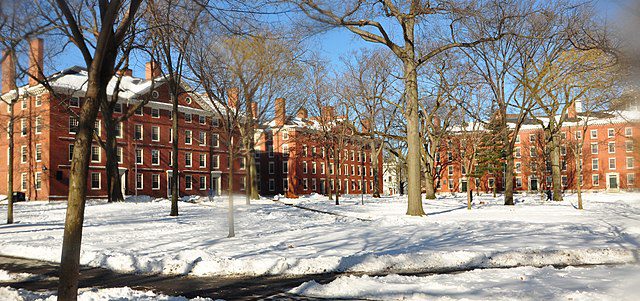Harvard now only Ivy without QuestBridge
Following Cornell’s recent decision to partner with QuestBridge, Harvard has become the only Ivy League school not to work with the organization. Low-income students at Yale and Harvard told the News about how QuestBridge affected their admissions process.

Wikimedia Commons
When QuestBridge announced on Thursday that it would begin to partner with Cornell University in 2025, Harvard University became the only Ivy League school to not offer admission through the organization’s National College Match program, which connects low-income students with full scholarships to selective colleges.
The News spoke to former QuestBridge finalists at Yale and Harvard to understand the influence the QuestBridge program had on their college application process.
“I feel like QuestBridge is just a really, really amazing thing to have,” said Ihechikarageme Munonye, a student at Harvard who receives full financial aid. “It’s kind of unfortunate and almost a disservice to a lot of intelligent students who may not come from the most financially sound backgrounds to not have access to a school like Harvard.”
Munonye was a QuestBridge finalist but did not match with any of the schools she ranked in the National College Match process, so she applied to Harvard in the regular decision cycle.
Despite being the only Ivy League school not to partner with QuestBridge, Harvard has the highest economic diversity ranking of the conference, according to a New York Times Magazine article from September. Twenty-two percent of Harvard students receive Pell grants; Yale and Columbia trail closely behind at 21 percent each.
Even so, Munonye said that she believes partnering with QuestBridge would likely encourage more low-income students to apply to Harvard.
Munonye explained that she had not originally planned on applying to Harvard because it was outside of the QuestBridge application and she did not realize that many schools, including Harvard, independently grant large amounts of need-based aid.
“I learned about institutions giving out aid, funnily enough, through QuestBridge,” Munonye said. “It was through a seminar they had that was very much to encourage low-income students to apply to Ivy League schools.”
Jeremiah Quinlan, dean of undergraduate admissions and financial aid at Yale, said that part of the appeal of being a QuestBridge partner is the program’s ability to amplify messaging about affordability and financial aid to high-achieving low-income students.
Yale has been a QuestBridge partner for 17 years and welcomed its most recent class of QuestBridge match scholars in December.
Emily Zenner ’24, a QuestBridge scholar who was admitted to Yale in the regular decision cycle, said that she had never considered attending college out-of-state until QuestBridge reached out to her about affordability.
She added that when she did apply, she ranked schools in part based on her familiarity with them, including their name cachet. Because Zenner only applied to out-of-state schools that partnered with QuestBridge, she never submitted any application to Harvard, despite its prestige.
“I definitely would have put Harvard on there and applied,” she said. “[I feel like] there’s some sort of idea that Harvard had that they were such a big name brand, they didn’t need to be discovered through QuestBridge.”
Munonye spoke to this point, saying that the main reason she applied to Harvard in the regular decision round was because of its renown.
In 2008, the Harvard Crimson reported that William Fitzsimmons, who has served as Harvard’s dean of admissions and financial aid for 38 years, cited Harvard’s robust outreach to low-income students and the fee colleges pay to participate in QuestBridge as the reasons the school has yet to become a partner.
The price colleges pay Questbridge to be listed as a partner is not publicly available, but the QuestBridge website states that “college partners use a combination of their own funds as well as state and federal aid to fund the scholarship.”
Fifty-five percent of Harvard undergraduates and more than 50 percent of Yale undergraduates receive some level of need-based aid, according to the Harvard and Yale websites respectively. At Yale, this 50 percent includes QuestBridge scholars. Harvard guarantees full scholarships to students whose families earn less than $85,000 per year –– it has raised the threshold by $10,000 each year for the past two years. Yale still makes the promise at a lower bar of $65,000.
Harvard College also established the Harvard Financial Aid Initiative in 2004, a recruitment program intending to “raise awareness of college affordability.” The Initiative’s budget has increased by more than 200 percent since its formation, from $80 million to $246 million.
At the time of the Crimson’s interview with Fitzsimmons in 2008, Harvard did not offer an early application round, and Fitzsimmons mentioned that early action admission programs like QuestBridge disadvantage low-income students because applicants are unable to compare aid packages across colleges after they receive regular decisions. Harvard reinstated their non-binding early admissions program in 2011 but the News could not find evidence that the school reconsidered their participation in QuestBridge then.
The 72 newly-admitted Yale QuestBridge match students who were accepted in December will join the approximately 306 QuestBridge scholars currently at Yale.
“Ultimately, having a lot of talented, high achieving, low-income students from around the country apply to Yale using the QuestBridge application and through the QuestBridge match program is a valuable part of our admissions process,” Quinlan told the News.
Representatives from QuestBridge and the Harvard Admissions Office did not respond to multiple requests for comment.
Around 10.8 percent of QuestBridge applicants matched with a partner school in 2023.







